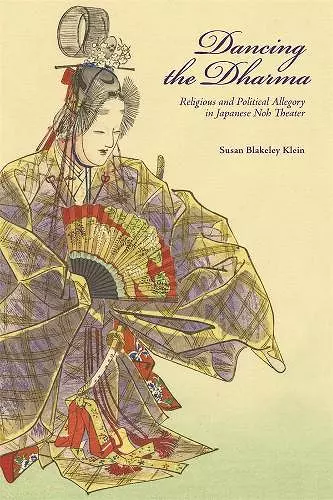Dancing the Dharma
Religious and Political Allegory in Japanese Noh Theater
Format:Hardback
Publisher:Harvard University Press
Published:30th Apr '21
Should be back in stock very soon

Dancing the Dharma examines the theory and practice of allegory by exploring a select group of medieval Japanese noh plays and treatises. Susan Blakeley Klein demonstrates how medieval esoteric commentaries on the tenth-century poem-tale Ise monogatari (Tales of Ise) and the first imperial waka poetry anthology Kokin wakashū influenced the plots, characters, imagery, and rhetorical structure of seven plays (Maiguruma, Kuzu no hakama, Unrin’in, Oshio, Kakitsubata, Ominameshi, and Haku Rakuten) and two treatises (Zeami’s Rikugi and Zenchiku’s Meishukushū). In so doing, she shows that it was precisely the allegorical mode—vital to medieval Japanese culture as a whole—that enabled the complex layering of character and poetic landscape we typically associate with noh. Klein argues that understanding noh’s allegorical structure and paying attention to the localized historical context for individual plays are key to recovering their original function as political and religious allegories. Now viewed in the context of contemporaneous beliefs and practices of the medieval period, noh plays take on a greater range and depth of meaning and offer new insights to readers today into medieval Japan.
Takes a fresh and illuminating approach to the interpretation of Noh texts. …This book is deeply interdisciplinary, and Klein is painstaking in her efforts to address the religious and historical contexts needed to capture a glimpse of how Muromachi readers and audiences may have thought about these texts. Dancing the Dharma should appeal to a broad range of readers, including specialists in literary studies, history, drama, poetics, and religious studies, and it makes a significant contribution to scholarship in all those fields. -- Shelley Fenno Quinn * Journal of Asian Studies *
If we wish to understand better the ways in which medieval Japanese people understood their world (I know I do), then we would do well to attend to allegoresis and the esoteric, sometimes outlandish, readings they applied to the same classic texts we are reading today for different reasons. … Klein has plowed through them with aplomb and constructed interesting but convincing readings of these difficult texts. A worthy follow-up to her previous book, Dancing the Dharma makes a significant contribution to our understanding of medieval Japanese literature, religion, and drama. -- Paul S. Atkins * Monumenta Nipponica *
…The author’s research and argumentation remain meticulous and precise, with painstakingly detailed discussions and contextualizations that point to new implications for each play. In this sense, Dancing the Dharma performatively enacts the analytical strategies of its object of study: by disentangling the intricate layers of meaning in nō plays that are not immediately apparent to the uninitiated, Klein instructs the readers about the ways in which such plays should be experienced and understood more fully. -- Terry Kawashima * Journal of Japanese Studies *
ISBN: 9780674247840
Dimensions: unknown
Weight: unknown
424 pages